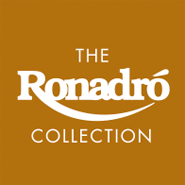ART IN THE MAKING
The Creation Of A Ronadró Bronze by use of the traditional lost wax casting process.
ln the Ronadró studio the master sculptor puts the finishing touches on his latest work of fine art. With artistic lines and accurate interpretation, this newest sculpture, honoring the medical and dental profession is now ready for an amazing and complicated series of events which will culminate in a richly patined, beautifully conceived and executed work of fine art. This fragile work of art is carefully transported to the foundry. The sculpture is to be produced by Michael Hall’s Studio Foundry, in Driftwood, Texas, only seven miles from the Ronadró studio. Ronadró and Michael Hall have worked closely together since the late 1980’s, Hall often acting as a technical advisor, regarding the intricacies of the molding and bronze casting process, thus allowing Ronadró to achieve remarkable compositions in balance and dynamics, unattainable by most artists.
THE MOLD MAKING
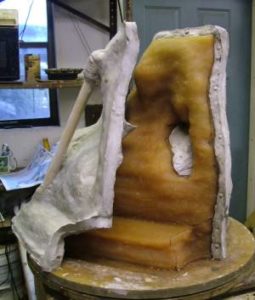 Ronadró’s original sculpture may initially be created in a wide variety of materials, including plasticine, (an oil based clay) terra cotta or stoneware, (water based clay) plaster, wood or wax. These different mediums allow Ronadró to create the unique texture varieties so recognizable throughout his collections of fine art. The lost wax process also referred to as cire pardue, requires first, the careful engineering of a quality mold, made from Ronadró’s original sculpture. This flexible rubber mold is used to create a hollow wax copy of the original, which is eventually “lost”, at last to be replaced with molten bronze. Rubber molds, most commonly made from different types of cold molding compounds, activated by catalyzers, are brushed or poured onto the surface of the original. The mold is removed, in several sections, if the original art is larger than about hand size. These rubber mold sections are supported by a plaster casing, called the “mother mold”, allowing the flexible rubber mold to be held rigid enough, and in perfect form for the wax pouring stage of the process. The complex network of rubber sections are keyed, all components bound together within the mother mold, and sealed for pouring. This rubber mold is used each time the artist desires to create another copy of the sculpture. The series or reproductions of an original work of art is termed an edition.
Ronadró’s original sculpture may initially be created in a wide variety of materials, including plasticine, (an oil based clay) terra cotta or stoneware, (water based clay) plaster, wood or wax. These different mediums allow Ronadró to create the unique texture varieties so recognizable throughout his collections of fine art. The lost wax process also referred to as cire pardue, requires first, the careful engineering of a quality mold, made from Ronadró’s original sculpture. This flexible rubber mold is used to create a hollow wax copy of the original, which is eventually “lost”, at last to be replaced with molten bronze. Rubber molds, most commonly made from different types of cold molding compounds, activated by catalyzers, are brushed or poured onto the surface of the original. The mold is removed, in several sections, if the original art is larger than about hand size. These rubber mold sections are supported by a plaster casing, called the “mother mold”, allowing the flexible rubber mold to be held rigid enough, and in perfect form for the wax pouring stage of the process. The complex network of rubber sections are keyed, all components bound together within the mother mold, and sealed for pouring. This rubber mold is used each time the artist desires to create another copy of the sculpture. The series or reproductions of an original work of art is termed an edition.
THE WAX CASTING
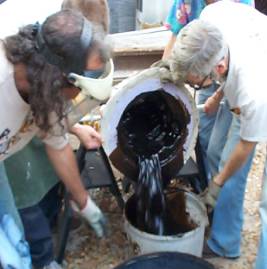 The new mold is now ready for creating a hollow, wax positive, capturing in thumbprint detail, the exact work originally sculpted. This, and every wax will ultimately be lost in the “burn-out” part of the process. Studio Foundry makes and uses a specially formulated pattern casting wax, which is heated and carefully poured into the mold. The mold is gently rotated to insure an even coating, always being mindful of surface bubble elimination. The wax may also be brushed into the open mold for the first coat, after which the mold sections are then closed and bound for additional wax pourings. Several wax pours at specific temperatures are necessary to develop the required wall thickness of the wax sculpture, approximately one-eighth inch, which must be relatively uniform to insure a good metal pour. lf the wax is not consistent, thinner areas will inhibit the smooth flow of the molten bronze, resulting in unseen weaknesses in the final cast, or even an unusable casting due to voids.
The new mold is now ready for creating a hollow, wax positive, capturing in thumbprint detail, the exact work originally sculpted. This, and every wax will ultimately be lost in the “burn-out” part of the process. Studio Foundry makes and uses a specially formulated pattern casting wax, which is heated and carefully poured into the mold. The mold is gently rotated to insure an even coating, always being mindful of surface bubble elimination. The wax may also be brushed into the open mold for the first coat, after which the mold sections are then closed and bound for additional wax pourings. Several wax pours at specific temperatures are necessary to develop the required wall thickness of the wax sculpture, approximately one-eighth inch, which must be relatively uniform to insure a good metal pour. lf the wax is not consistent, thinner areas will inhibit the smooth flow of the molten bronze, resulting in unseen weaknesses in the final cast, or even an unusable casting due to voids.
WAX CHASING
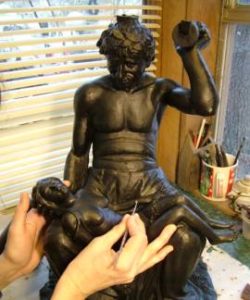 The wax is then given enough time, in the undisturbed mold, to cool, after which it can be carefully removed from the rubber mold. Chasing, a term which means to clean and re-sculpt, is done twice, once in the wax and again when the sculpture is in bronze. Wax chasing is done with heated metal spatulas, knives, and assorted wax sculpting tools, allowing the wax chaser to remove any flashings, or irregular fins of excess material, which may have seeped into tiny gaps between seams. Spru and vent joins are areas on the sculpture, where the molten wax has been channeled to fill the sculpture, and where vents have been designed in the mold to allow trapped air to escape, as the wax is being poured. These areas must also be chased off the sculpture, along with all other undesired surface irregularities, such as tiny bubbles which must be filled and re-textured. The wax pouring and chasing specialists at Studio Foundry are all artists, highly skilled in resurfacing the sculpture, to the exact requirements of Ronadró, often referring to the original art piece, to be certain of the utmost detail. Finally, the master himself is often called in to give his approval, and the process continues.
The wax is then given enough time, in the undisturbed mold, to cool, after which it can be carefully removed from the rubber mold. Chasing, a term which means to clean and re-sculpt, is done twice, once in the wax and again when the sculpture is in bronze. Wax chasing is done with heated metal spatulas, knives, and assorted wax sculpting tools, allowing the wax chaser to remove any flashings, or irregular fins of excess material, which may have seeped into tiny gaps between seams. Spru and vent joins are areas on the sculpture, where the molten wax has been channeled to fill the sculpture, and where vents have been designed in the mold to allow trapped air to escape, as the wax is being poured. These areas must also be chased off the sculpture, along with all other undesired surface irregularities, such as tiny bubbles which must be filled and re-textured. The wax pouring and chasing specialists at Studio Foundry are all artists, highly skilled in resurfacing the sculpture, to the exact requirements of Ronadró, often referring to the original art piece, to be certain of the utmost detail. Finally, the master himself is often called in to give his approval, and the process continues.
SPRUING
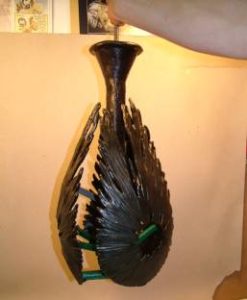 When the wax copy of the original sculpture meets the exacting requirements of the artist and foundry, a wax sprue system is designed, with a pouring cup, gates and vents, all attached to the perfect wax. Gates are systematically positioned along the wax to channel molten bronze into the casting mold, and vents are engineered to relieve air pressure inside the mold, to insure a smooth flow of metal into every recess, as the sculpture becomes bronze.
When the wax copy of the original sculpture meets the exacting requirements of the artist and foundry, a wax sprue system is designed, with a pouring cup, gates and vents, all attached to the perfect wax. Gates are systematically positioned along the wax to channel molten bronze into the casting mold, and vents are engineered to relieve air pressure inside the mold, to insure a smooth flow of metal into every recess, as the sculpture becomes bronze.
INVESTMENT
Creating the casting mold. 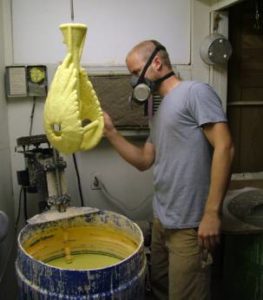 During the investment process, the ceramic shell is built up around the gated and vented wax sculpture, leaving the pouring cup and vents open, at the top, until the whole assembly is sufficiently thick enough to contain the weight of the molten bronze. The ceramic shell investment material, applied by repeated dipping, begins with a colloidal silica slurry. When wet with this slurry, dried silica is stuccoed over the entire surface, by means of a rainfall or fluidized sanding system. Depending on the size and weight of the whole wax assembly, numerous coats are applied, (usually about eight), in alternating layers of slurry and stucco. The final application may be reinforced with stainless steel mesh in areas where additional strength is determined necessary.
During the investment process, the ceramic shell is built up around the gated and vented wax sculpture, leaving the pouring cup and vents open, at the top, until the whole assembly is sufficiently thick enough to contain the weight of the molten bronze. The ceramic shell investment material, applied by repeated dipping, begins with a colloidal silica slurry. When wet with this slurry, dried silica is stuccoed over the entire surface, by means of a rainfall or fluidized sanding system. Depending on the size and weight of the whole wax assembly, numerous coats are applied, (usually about eight), in alternating layers of slurry and stucco. The final application may be reinforced with stainless steel mesh in areas where additional strength is determined necessary.
BURN-OUT
“Lost wax”.  Now the casting mold is complete and requires removal of the wax within, to make way for the sculpture to be poured in metal. The entire casting assembly, (called a tree), is then flash fired as it is placed in the burnout kiln, which has been pre-heated to 1800 degrees Fahrenheit. This high temperature serves both to fuse the ceramic shell and to burn out the wax entirely, including the volatilization of any carbon remaining from burned wax. Thusly, we now have a perfectly clean and very strong, cooling ceramic shell casting mold.
Now the casting mold is complete and requires removal of the wax within, to make way for the sculpture to be poured in metal. The entire casting assembly, (called a tree), is then flash fired as it is placed in the burnout kiln, which has been pre-heated to 1800 degrees Fahrenheit. This high temperature serves both to fuse the ceramic shell and to burn out the wax entirely, including the volatilization of any carbon remaining from burned wax. Thusly, we now have a perfectly clean and very strong, cooling ceramic shell casting mold.
THE POUR
Bronze & sculpture unite. 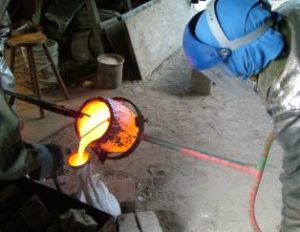 The wax burnout leaves a hollow mold, completely devoid of wax and ready to accept the molten bronze. After close examination for any cracks, and patching if necessary, the ceramic shell mold is returned to the kiln and brought up to approximately 1400 degrees Fahrenheit. At Studio Foundry, this is a time of reverence and concentration. The work of art has been through numerous, complicated and time-consuming steps to reach this one, critical moment in time. After the wax burnout and before the bronze pouring, the sculpture no longer exists as an object and is defined only by its absence in the casting mold. While the casting molds are being heated in the kiln, the forced air, gas fired furnace is lit. A silicon carbide graphite crucible, inside the furnace, is charged with bronze ingots. The composition of bronze used at Studio Foundry is 95% copper, 4% silicon and 1% manganese. lt is called Everdure Silicon Bronze. ln order to know what quantity of metal is required for this pouring, a wax weight to metal weight formula is used. The ratio for bronze is approximately ten pounds for every one pound of wax. As the bronze ingots in the furnace begin to melt, more ingots are added, charging the crucible until the desired amount is achieved. Fluxing agents which enhance the pour and trap impurities are added toward the end of the melt. The metal is then watched closely as it reaches its appropriate temperature for pouring, which for bronze is between 1940 degrees and 2200 degrees Fahrenheit. The desired pouring temperature is estimated for each mold, based on various characteristics unique to each sculpture to be poured. When the bronze reaches the required temperature, the ceramic shells are removed from the hot kiln, and carefully placed on a bed of sand, stabilized with the pouring cups straight up. The crucible is removed from the furnace with lift out tongs. The glowing crucible, charged with molten bronze, is placed in a pouring shank. Any slag or impurities that have floated to the metal’s surface are then removed with a skimmer. A two person team lifts the shank, containing the full crucible and carries it to the awaiting molds. The pour yard becomes quiet as the crucible is tilted toward the open cup, and a steady stream of iridescent gold liquid flows from crucible to mold. Once again, as with something akin to magic, the sculpture exists as a solid object. After the pour is complete the molds are allowed to cool. The cooled casting, encased in its ceramic shell investment, is then devested. Much of this work is done with air tools, switching to hand chisels as the sculpture’s more delicate areas are revealed.
The wax burnout leaves a hollow mold, completely devoid of wax and ready to accept the molten bronze. After close examination for any cracks, and patching if necessary, the ceramic shell mold is returned to the kiln and brought up to approximately 1400 degrees Fahrenheit. At Studio Foundry, this is a time of reverence and concentration. The work of art has been through numerous, complicated and time-consuming steps to reach this one, critical moment in time. After the wax burnout and before the bronze pouring, the sculpture no longer exists as an object and is defined only by its absence in the casting mold. While the casting molds are being heated in the kiln, the forced air, gas fired furnace is lit. A silicon carbide graphite crucible, inside the furnace, is charged with bronze ingots. The composition of bronze used at Studio Foundry is 95% copper, 4% silicon and 1% manganese. lt is called Everdure Silicon Bronze. ln order to know what quantity of metal is required for this pouring, a wax weight to metal weight formula is used. The ratio for bronze is approximately ten pounds for every one pound of wax. As the bronze ingots in the furnace begin to melt, more ingots are added, charging the crucible until the desired amount is achieved. Fluxing agents which enhance the pour and trap impurities are added toward the end of the melt. The metal is then watched closely as it reaches its appropriate temperature for pouring, which for bronze is between 1940 degrees and 2200 degrees Fahrenheit. The desired pouring temperature is estimated for each mold, based on various characteristics unique to each sculpture to be poured. When the bronze reaches the required temperature, the ceramic shells are removed from the hot kiln, and carefully placed on a bed of sand, stabilized with the pouring cups straight up. The crucible is removed from the furnace with lift out tongs. The glowing crucible, charged with molten bronze, is placed in a pouring shank. Any slag or impurities that have floated to the metal’s surface are then removed with a skimmer. A two person team lifts the shank, containing the full crucible and carries it to the awaiting molds. The pour yard becomes quiet as the crucible is tilted toward the open cup, and a steady stream of iridescent gold liquid flows from crucible to mold. Once again, as with something akin to magic, the sculpture exists as a solid object. After the pour is complete the molds are allowed to cool. The cooled casting, encased in its ceramic shell investment, is then devested. Much of this work is done with air tools, switching to hand chisels as the sculpture’s more delicate areas are revealed.
METAL CHASING
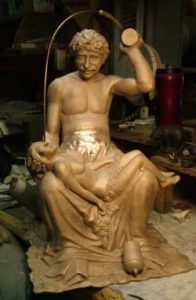 The spruing system with gates and vents, once in wax is now in bronze, must be completely removed. The surface of the sculpture is chased and retextured, to match the original. Many works are cast in sections and must be welded back together. When the metal chasing is complete, with utmost attention paid to every detail with regard to the design and surface quality of the original, a final sandblasting is performed, removing all oils and contaminates, preparing the bronze surface areas uniformly for patination.
The spruing system with gates and vents, once in wax is now in bronze, must be completely removed. The surface of the sculpture is chased and retextured, to match the original. Many works are cast in sections and must be welded back together. When the metal chasing is complete, with utmost attention paid to every detail with regard to the design and surface quality of the original, a final sandblasting is performed, removing all oils and contaminates, preparing the bronze surface areas uniformly for patination.
PATINATION
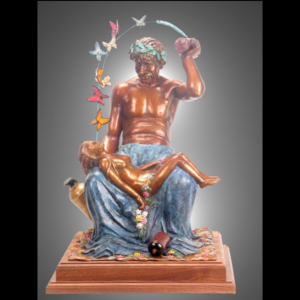 Patination is the process of applying a patina. Metal coloring, (patining), is not an exact science, but depends on the technical skill and artistic judgment of the patinuer, working closely with the sculptor. Patinas are used to create life-likeness in sculpture and are used symbolically, in both abstract and representational contexts, and more generally, to unify and enhance the aesthetics of a work of art. Although patinas may be thought of as a secondary characteristic of sculpture, often applied in a process that is distinct from that of creating the artwork, in many cases, it is the key factor in the visual coherence and artistic significance of a piece. Therefore, a patina is of prime importance. The long-term relationship between sculptor, Ronadró, and the patina specialists at Studio Foundry contributes greatly to achieve the distinct quality, represented in the often multi-colored, bronze sculpture created for the Ronadró Collection. Both hot and cold patina applications are used. Bronze reacts with certain acids and other chemicals, by oxidizing in different colors. For example, cupric nitrate applied to a hot bronze will oxidize with the metal changing its color to green. Ronadró and Studio Foundry, well known for their innovative patinas, have developed a broad pallet of colors exclusively for the Ronadró Collection with some of these effects only being found in this collection. The patination process also enhances the ability of the sculpture to sustain the effects of time and the elements.
Patination is the process of applying a patina. Metal coloring, (patining), is not an exact science, but depends on the technical skill and artistic judgment of the patinuer, working closely with the sculptor. Patinas are used to create life-likeness in sculpture and are used symbolically, in both abstract and representational contexts, and more generally, to unify and enhance the aesthetics of a work of art. Although patinas may be thought of as a secondary characteristic of sculpture, often applied in a process that is distinct from that of creating the artwork, in many cases, it is the key factor in the visual coherence and artistic significance of a piece. Therefore, a patina is of prime importance. The long-term relationship between sculptor, Ronadró, and the patina specialists at Studio Foundry contributes greatly to achieve the distinct quality, represented in the often multi-colored, bronze sculpture created for the Ronadró Collection. Both hot and cold patina applications are used. Bronze reacts with certain acids and other chemicals, by oxidizing in different colors. For example, cupric nitrate applied to a hot bronze will oxidize with the metal changing its color to green. Ronadró and Studio Foundry, well known for their innovative patinas, have developed a broad pallet of colors exclusively for the Ronadró Collection with some of these effects only being found in this collection. The patination process also enhances the ability of the sculpture to sustain the effects of time and the elements.
 Ronadró’s original sculpture may initially be created in a wide variety of materials, including plasticine, (an
Ronadró’s original sculpture may initially be created in a wide variety of materials, including plasticine, (an  The new mold is now ready for creating a hollow,
The new mold is now ready for creating a hollow,  The wax is then given enough time, in the undisturbed mold, to cool, after which it can be carefully removed from the rubber mold. Chasing, a term which means to clean and re-sculpt, is done twice, once in the wax and again when the sculpture is in bronze. Wax chasing is done with heated metal spatulas, knives, and assorted wax sculpting tools, allowing the wax chaser to remove any flashings, or irregular fins of excess material, which may have seeped into tiny gaps between seams.
The wax is then given enough time, in the undisturbed mold, to cool, after which it can be carefully removed from the rubber mold. Chasing, a term which means to clean and re-sculpt, is done twice, once in the wax and again when the sculpture is in bronze. Wax chasing is done with heated metal spatulas, knives, and assorted wax sculpting tools, allowing the wax chaser to remove any flashings, or irregular fins of excess material, which may have seeped into tiny gaps between seams.  When the wax copy of the original sculpture meets the exacting requirements of the artist and foundry, a wax sprue system is designed, with a pouring cup, gates and vents, all attached to the perfect wax. Gates are systematically positioned along the
When the wax copy of the original sculpture meets the exacting requirements of the artist and foundry, a wax sprue system is designed, with a pouring cup, gates and vents, all attached to the perfect wax. Gates are systematically positioned along the  During the investment process, the ceramic shell is built up around the gated and vented wax sculpture, leaving the pouring cup and vents open, at the top, until the whole assembly is sufficiently thick enough to contain the weight of the molten bronze. The ceramic shell investment material, applied by repeated dipping, begins with a colloidal silica slurry. When wet with this slurry, dried silica is stuccoed over the entire surface, by means of a rainfall or fluidized sanding system. Depending on the size and weight of the whole wax assembly, numerous coats are applied, (usually about eight), in alternating layers of slurry and stucco. The final application may be reinforced with stainless steel mesh in areas where additional strength is determined necessary.
During the investment process, the ceramic shell is built up around the gated and vented wax sculpture, leaving the pouring cup and vents open, at the top, until the whole assembly is sufficiently thick enough to contain the weight of the molten bronze. The ceramic shell investment material, applied by repeated dipping, begins with a colloidal silica slurry. When wet with this slurry, dried silica is stuccoed over the entire surface, by means of a rainfall or fluidized sanding system. Depending on the size and weight of the whole wax assembly, numerous coats are applied, (usually about eight), in alternating layers of slurry and stucco. The final application may be reinforced with stainless steel mesh in areas where additional strength is determined necessary. Now the casting mold is complete and requires removal of the wax within, to make way for the sculpture to be poured in metal. The entire casting assembly, (called a tree), is then flash fired as it is placed in the burnout kiln, which has been pre-heated to 1800 degrees Fahrenheit. This high temperature serves both to fuse the ceramic shell and to burn out the wax entirely, including the volatilization of any carbon remaining from burned wax. Thusly, we now have a perfectly clean and very strong, cooling ceramic shell casting mold.
Now the casting mold is complete and requires removal of the wax within, to make way for the sculpture to be poured in metal. The entire casting assembly, (called a tree), is then flash fired as it is placed in the burnout kiln, which has been pre-heated to 1800 degrees Fahrenheit. This high temperature serves both to fuse the ceramic shell and to burn out the wax entirely, including the volatilization of any carbon remaining from burned wax. Thusly, we now have a perfectly clean and very strong, cooling ceramic shell casting mold. The wax burnout leaves a hollow mold, completely devoid of wax and ready to accept the molten bronze. After close examination for any cracks, and patching if necessary, the ceramic shell mold is returned to the kiln and brought up to approximately 1400 degrees Fahrenheit. At Studio Foundry, this is a time of reverence and concentration. The work of art has been through numerous, complicated and time-consuming steps to reach this one, critical moment in time. After the wax burnout and before the bronze pouring, the sculpture no longer exists as an object and is defined only by its absence in the casting mold. While the casting molds are being heated in the kiln, the forced air,
The wax burnout leaves a hollow mold, completely devoid of wax and ready to accept the molten bronze. After close examination for any cracks, and patching if necessary, the ceramic shell mold is returned to the kiln and brought up to approximately 1400 degrees Fahrenheit. At Studio Foundry, this is a time of reverence and concentration. The work of art has been through numerous, complicated and time-consuming steps to reach this one, critical moment in time. After the wax burnout and before the bronze pouring, the sculpture no longer exists as an object and is defined only by its absence in the casting mold. While the casting molds are being heated in the kiln, the forced air,  The
The  Patination is the process of applying a patina. Metal coloring, (patining), is not an exact science, but depends on the technical skill and artistic judgment of the
Patination is the process of applying a patina. Metal coloring, (patining), is not an exact science, but depends on the technical skill and artistic judgment of the 